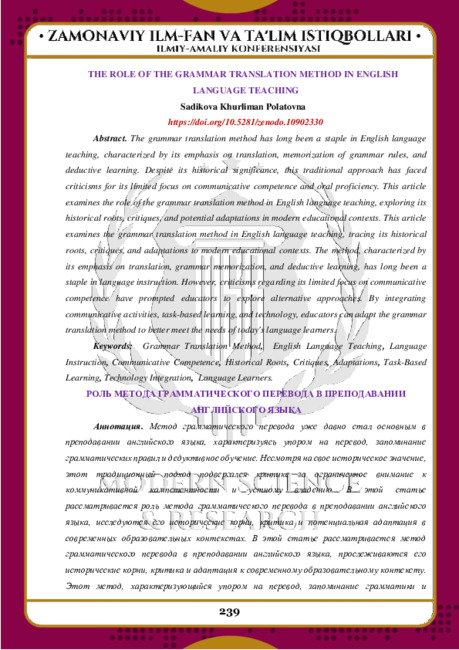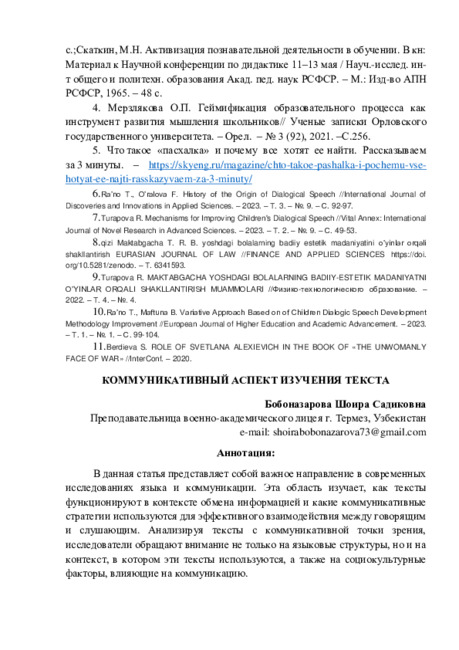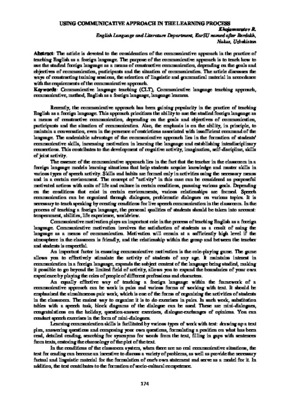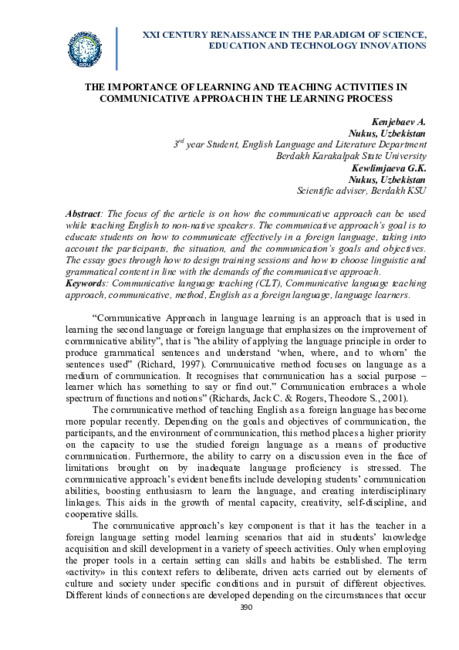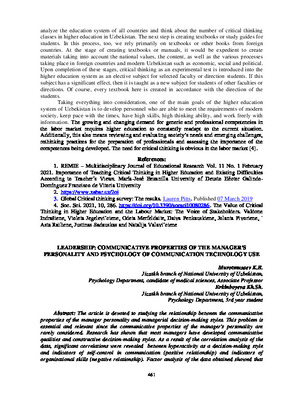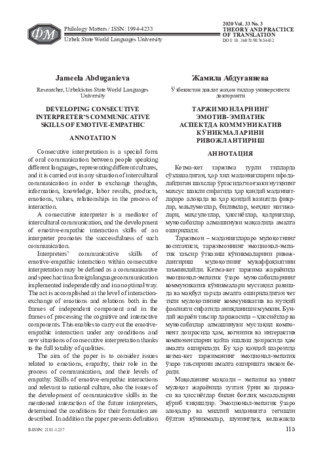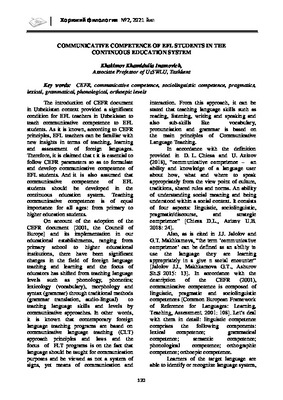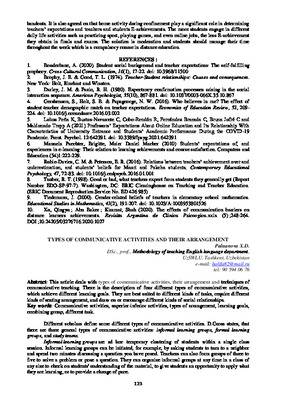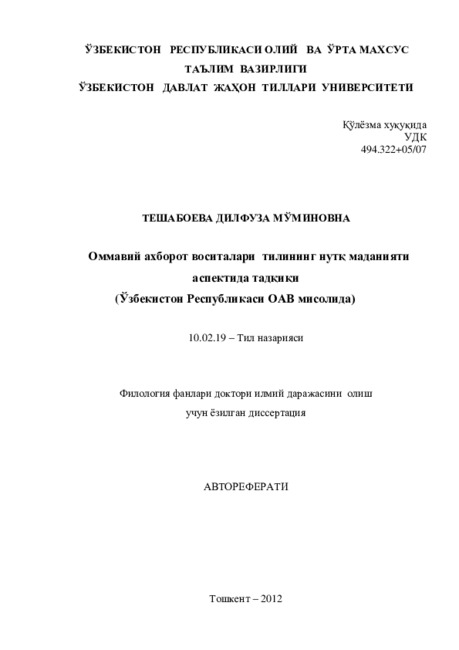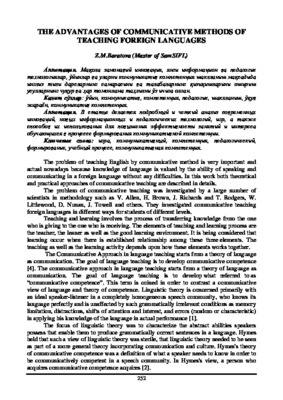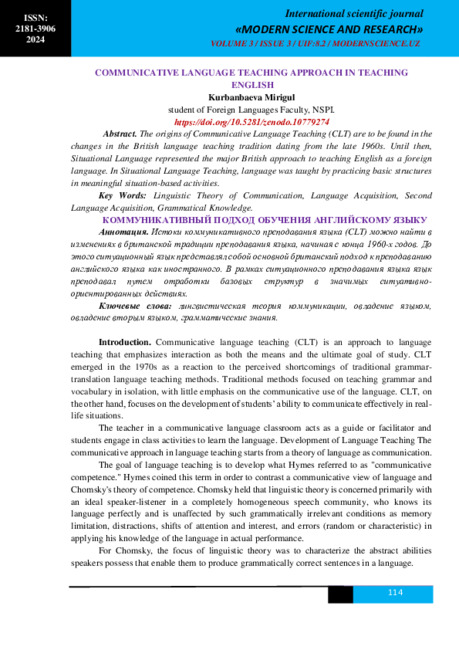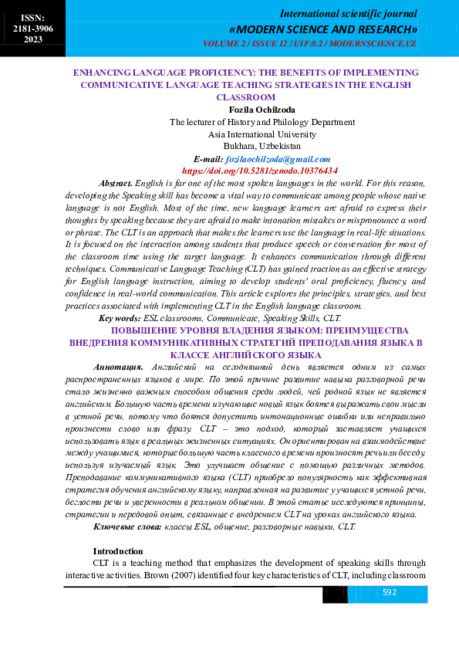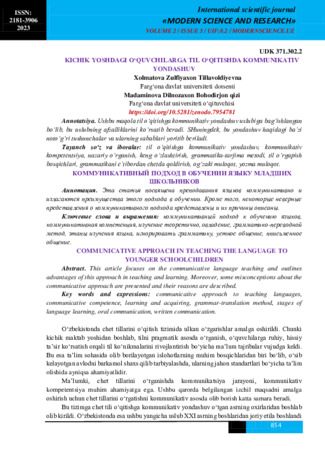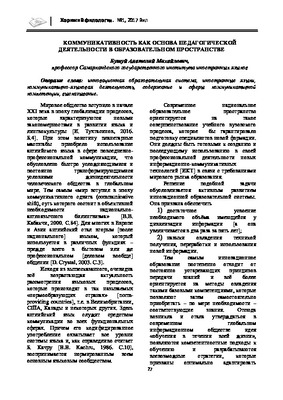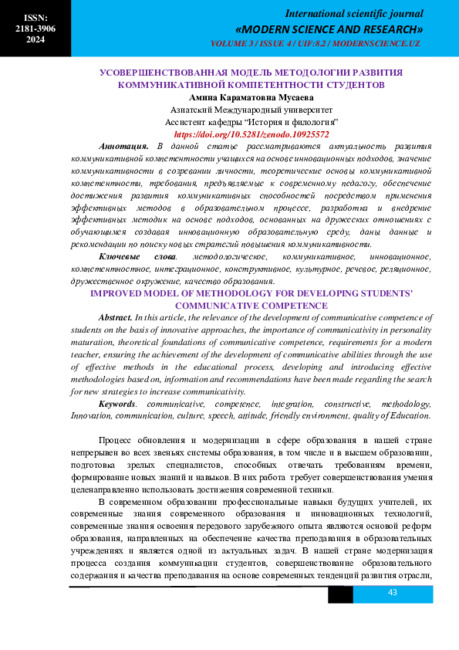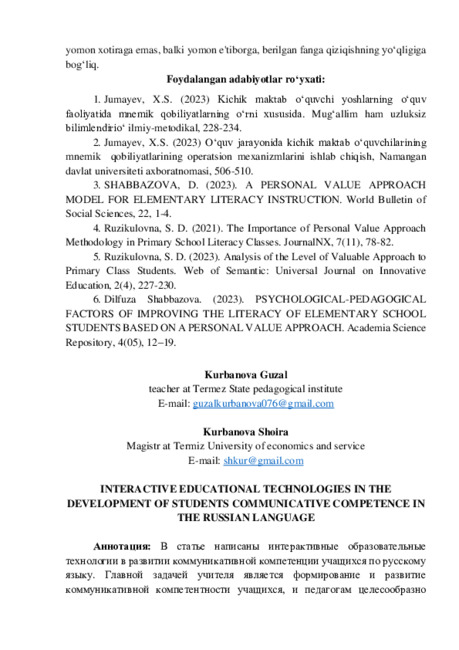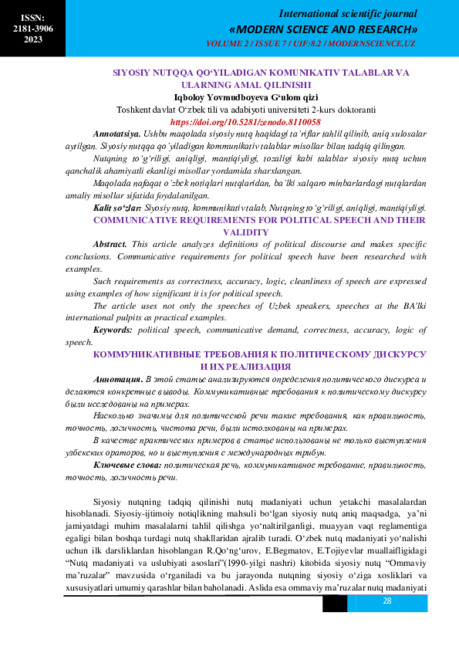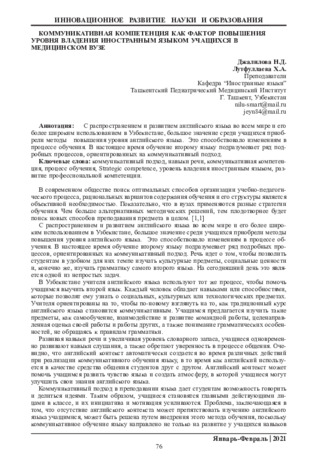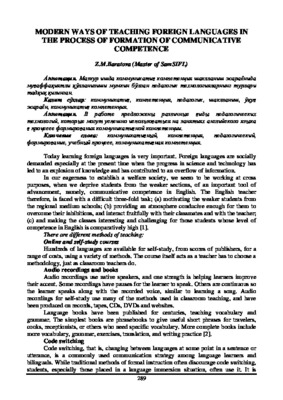Поиск по библиотеке
Результаты поиска
-
РОЛЬ МЕТОДА ГРАММАТИЧЕСКОГО ПЕРЕВОДА В ПРЕПОДАВАНИИ АНГЛИЙСКОГО ЯЗЫКАМетод грамматического перевода уже давно стал основным в преподавании английского языка, характеризуясь упором на перевод, запоминание грамматических правил и дедуктивное обучение. Несмотря на свое историческое значение, этот традиционный подход подвергался критике за ограниченное внимание к коммуникативной компетентности и устному владению. В этой статье рассматривается роль метода грамматического перевода в преподавании английского языка, исследуются его исторические корни, критика и потенциальная адаптация в современных образовательных контекстах. В этой статье рассматривается метод грамматического перевода в преподавании английского языка, прослеживаются его исторические корни, критика и адаптация к современному образовательному контексту. Этот метод, характеризующийся упором на перевод, запоминание грамматики и дедуктивное обучение, уже давно стал основным в обучении языку. Однако критика в отношении ограниченного внимания к коммуникативной компетентности побудила преподавателей изучить альтернативные подходы. Интегрируя коммуникативную деятельность, обучение на основе задач и технологии, преподаватели могут адаптировать метод грамматического перевода для лучшего удовлетворения потребностей современных изучающих язык.
Современная наука и исследования -
В данная статья представляет собой важное направление в современных исследованиях языка и коммуникации. Эта область изучает, как тексты функционируют в контексте обмена информацией и какие коммуникативные стратегии используются для эффективного взаимодействия между говорящим и слушающим. Анализируя тексты с коммуникативной точки зрения, исследователи обращают внимание не только на языковые структуры, но и на контекст, в котором эти тексты используются, а также на социокультурные факторы, влияющие на коммуникацию. Данная тема предоставляет возможность рассмотреть различные аспекты коммуникативного изучения текста, включая его функциональное назначение, структуру, воздействие на аудиторию и взаимосвязь с культурными особенностями общества. В работе с этой темой исследователи могут проводить анализ различных текстовых жанров — от литературных произведений до публичных выступлений — и выявлять особенности их коммуникативного воздействия. В итоге, понимание коммуникативных аспектов текста не только способствует глубокому анализу языковых структур, но и помогает расширить наши знания о том, как тексты служат средством общения и взаимодействия в современном мире.
-
Using communicative approach in the learning processThe article is devoted to the consideration of the communicative approach in the practice of teaching English as a foreign language. The purpose of the communicative approach is to teach how to use the studied foreign language as a means of constructive communication, depending on the goals and objectives of communication, participants and the situation of communication. The article discusses the ways of constructing training sessions, the selection of linguistic and grammatical material in accordance with the requirements of the communicative approach.
Ренессанс в парадигме новаций образования и технологий в XXI веке -
The importance of learning and teaching activities in communicative approach in the learning process
Ренессанс в парадигме новаций образования и технологий в XXI векеThe focus of the article is on how the communicative approach can be used while teaching English to non-native speakers. The communicative approach’s goal is to educate students on how to communicate effectively in a foreign language, taking into account the participants, the situation, and the communication’s goals and objectives. The essay goes through how to design training sessions and how to choose linguistic and grammatical content in line with the demands of the communicative approach.
-
Leadership: communicative properties of the manager's personality and psychology of communication technology useThe article is devoted to studying the relationship between the communicative properties of the manager personality and managerial decision-making styles. This problem is essential and relevant since the communicative properties of the manager's personality are rarely considered. Research has shown that most managers have developed communicative qualities and constructive decision-making styles. As a result of the correlation analysis of the data, significant correlations were revealed between hyperactivity as a decision-making style and indicators of self-control in communication (positive relationship) and indicators of organisational skills (negative relationship). Factor analysis of the data obtained showed that the communicative properties of a person could be combined with hyper-vigilance as a decision-making style, forming the factors "self-control" and "impulsive sociability". The present study extends existing communication technology and organizational literatures by going beyond usage assessments and examining how an employee‘s psychological state influences motivations for non-work-related communication technology use during company time.
Современные инновационные исследования актуальные проблемы и развитие тенденции: решения и перспективы -
Consecutive interpretation is a special form of oral communication between people speaking different languages, representing different cultures, and it is carried out in any situation of intercultural communication in order to exchange thoughts, information, knowledge, labor results, products, emotions, values, relationships in the process of interaction. A consecutive interpreter is a mediator of intercultural communication, and the development of emotive-empathic interaction skills of an interpreter promotes the successfulncss of such communication. Interpreters’ communicative skills of emotive-empathic interaction within consecutive interpretation may be defined as a communicative and speech act in a foreign language communication implemented independently and in an optimal way. The act is accomplished at the level of interactionexchange of emotions and relations both in the frames of independent component and in the frames of processing the cognitive and interactive components. This enables to carry out the cmotivc-cmpathic interaction under any conditions and new situations of consecutive interpretation thanks to the full totality of qualities. The aim of the paper is to consider issues related to emotions, empathy, their role in the process of communication, and their levels of empathy. Skills of emotive-empathic interactions and relevant to national culture, also the issues of the development of communicative skills in the mentioned interaction of the future interpreters, determined the conditions for their formation arc described. In addition the paper presents definition of the communicative ability of the emotive-empathic interaction of future interpreters; considers a set of exercises aimed at the formation of these skills. The results of the scientific research are presented by the set of exercises.
-
Коммуникативная компетентность студентов EFL в система непрерывного образованияОбщеевропейская система ориентиров по языкам, другими словами, CEFR играет ведущую роль в формировании и развитии коммуникативной компетентности студентов EFL (изучение английского как иностранного языка), а также преподавателей. Благодаря знакомству с когнитивными навыками люди могут общаться с иностранцами или повышать коммуникативную компетентность. Кроме того, коммуникативная компетенция может быть дополнительно сформулирована путем развития социолингвистической компетенции для студентов EFL
Иностранная филология: язык, литература, образование -
Types of communicative activities and their arrangementThis article deals with types of communicative activities, their arrangement and techniques of communicative teaching. There is the description of four different types of communicative activities, which achieve different learning goals. They are best suited to different kinds of tasks, require different kinds of seating arrangement, and draw on or encourage different kinds of social relationships.
Ренессанс в парадигме новаций образования и технологий в XXI веке -
Исследование языка СМИ в аспекте культуры речи (на материале СМИ Республики Узбекистан
Каталог авторефератовОбъект исследования: объект диссертационной работы - язык средств массовой информации.
Предмет исследования: нормативный, коммуникативный и этический аспекты культуры речи языка СМИ.
Цель исследования: исследование культуры речи в средствах массовой информации в нормативном, коммуникативном и этическом аспектах.
Методы исследования: метод лингвистического описания, метод семантикостилистического анализа, метод компонентного анализа, метод текстового анализа, сравнительный метод, метод акустического анализа (радио и телевидение), анкетирование.
Полученные результаты и их новизна: впервые язык СМИ ( газеты, телевидения и радио) исследован в качестве объекта монографического исследования в нормативном, коммуникативном и этическом аспектах культуры речи; определены принципы изучения в языковедении вопросов языка и культуры речи СМИ; раскрыта современная концепция культуры речи; показано своеобразие проявления культуры речи в языке СМИ; проанализированы особенности языка СМИ; раскрыта национальная специфика языка СМИ; изучены социо-психолингвистические и функционально-коммуникативные качества языка газеты; определена экпрессивность языка газеты и ее рече-культурная оценка; проанализирован язык газеты, телевидения и радио в аспекте культуры речи; освещены особенности языка телевидения и радио, его экспрессивность и речекультурная оценка; проанализирован нормативный аспект культуры речи в СМИ; исследован коммуникативный аспект культуры речи СМИ; освещена этический аспект культуры речи в СМИ; раскрыта взаимосвязь аспектов культуры речи СМИ.
Практическое значение: материалы исследования могут быть использованы при проведении занятий по общему и узбекскому языкознанию, культуре речи, стилистике, риторике, журналистике, социолингвистики, психолингвистике, при написании диссертаций, монографии, учебников, учебных пособий.
Степень внедрения: результаты и материалы исследования внедрены в практику преподования курсов «Язык и стиль СМИ», «Язык и стиль прессы», «Язык электронных СМИ», «Основы риторики и ораторское исскуство», «Коммуникативное качество», «Основы культуры речи» и спец.курса «Язык СМИ как средство манипулирование общественного сознания» на факультете международной журналистики Узбекского государственного университета мировых языков, а также на кафедре узбекского языкознания (направление культура речи и ораторское исскуство) Национального университета Узбекистана.
Область применения: общее и узбекское языкознание, стилистика, социолингвистика, психолингвистика, культура речи, ораторское искусство. -
Преимущества коммуникативных методов обучения иностранным языкамВ статье делается подробный и четкий анализ современных инноваций, новых информационных и педагогических технологий, игр, а также способов их использования для повышения эффективности занятий и интереса обучающихся в процессе формирования коммуникативной компетенции.
Современные лингвистические исследования: зарубежный опыт, перспективные исследования и инновационные методы преподавания языков -
Студенты и специалисты считают, что изучение английского языка необходимо, чтобы оставаться конкурентоспособными в учебе и карьере в связи с быстрой глобализацией мира. Мы также живем в эпоху специализаций. Люди обладают специальными знаниями в различных областях; Самый эффективный способ получения такого рода информации — изучение нескольких языков, особенно английского, который широко используется во всем мире. В исследовании изучалось влияние использования чтения на английском языке для специальных целей в рамках коммуникативного подхода, и результаты были представлены в этой статье для группы студентов-юристов. Результаты показывают, что специализированное чтение побуждает учащихся использовать английский язык в повседневном контексте и расширяет их словарный запас и знания в конкретной области обучения.
-
Истоки коммуникативного преподавания языка (CLT) можно найти в изменениях в британской традиции преподавания языка, начиная с конца 1960-х годов. До этого ситуационный язык представлял собой основной британский подход к преподаванию английского языка как иностранного. В рамках ситуационного преподавания языка язык преподавал путем отработки базовых структур в значимых ситуативно-ориентированных действиях.
-
ПОВЫШЕНИЕ УРОВНЯ ВЛАДЕНИЯ ЯЗЫКОМ: ПРЕИМУЩЕСТВА ВНЕДРЕНИЯ КОММУНИКАТИВНЫХ СТРАТЕГИЙ ПРЕПОДАВАНИЯ ЯЗЫКА В КЛАССЕ АНГЛИЙСКОГО ЯЗЫКААнглийский на сегодняшний день является одним из самых распространенных языков в мире. По этой причине развитие навыка разговорной речи стало жизненно важным способом общения среди людей, чей родной язык не является английским. Большую часть времени изучающие новый язык боятся выражать свои мысли в устной речи, потому что боятся допустить интонационные ошибки или неправильно произнести слово или фразу. CLT – это подход, который заставляет учащихся использовать язык в реальных жизненных ситуациях. Он ориентирован на взаимодействие между учащимися, которые большую часть классного времени произносят речь или беседу, используя изучаемый язык. Это улучшает общение с помощью различных методов. Преподавание коммуникативного языка (CLT) приобрело популярность как эффективная стратегия обучения английскому языку, направленная на развитие у учащихся устной речи, беглости речи и уверенности в реальном общении. В этой статье исследуются принципы, стратегии и передовой опыт, связанные с внедрением CLT на уроках английского языка.
Современная наука и исследования -
Эта статья посвящена преподавания языков коммуникативно и излагаются преимущества этого подхода в обучении. Кроме того, некоторые неверные представления о коммуникативного подхода представлены и их причины описаны.
-
Коммуникативность как основа педагогической деятельности в образовательном пространстве.Автор проводит комплексный анализ коммуникативного подхода к иностранному языку.Преподавания языков, обосновывает необходимость его немедленного внедрения в педагогическую практику. Он также рассматривает теоретические вопросы, связанные с коммуникативной лингвистикой, и предлагает средства для решить их.
Иностранная филология: язык, литература, образование -
УСОВЕРШЕНСТВОВАННАЯ МОДЕЛЬ МЕТОДОЛОГИИ РАЗВИТИЯ КОММУНИКАТИВНОЙ КОМПЕТЕНТНОСТИ СТУДЕНТОВВ данной статье рассматриваются актуальность развития коммуникативной компетентности учащихся на основе инновационных подходов, значение коммуникативности в созревании личности, теоретические основы коммуникативной компетентности, требования, предъявляемые к современному педагогу, обеспечение достижения развития коммуникативных способностей посредством применения эффективных методов в образовательном процессе, разработка и внедрение эффективных методик на основе подходов, основанных на дружеских отношениях с обучающимся создавая инновационную образовательную среду, даны данные и рекомендации по поиску новых стратегий повышения коммуникативности.
Современная наука и исследования -
Интерактивные образовательные технологии в развитии коммуникативной компетентности студентов по русскому языку
Традиции и инновации в исследовании и преподавании языковВ статье написаны интерактивные образовательные технологии в развитии коммуникативной компетенции учащихся по русскому языку. Главной задачей учителя является формирование и развитие коммуникативной компетентности учащихся, и педагогам целесообразно сделать основной задачей своей деятельности использование методов и технологий, позволяющих учащимся самостоятельно и свободно общаться на русском языке. Такая деятельность должна вызывать у учащихся желание общаться на изучаемом языке, и это общение должно приносить учащимся радость.
-
КОММУНИКАТИВНЫЕ ТРЕБОВАНИЯ К ПОЛИТИЧЕСКОМУ ДИСКУРСУ И ИХ РЕАЛИЗАЦИЯThis article analyzes definitions of political discourse and makes specific conclusions. Communicative requirements for political speech have been researched with examples. Such requirements as correctness, accuracy, logic, cleanliness of speech are expressed using examples of how significant it is for political speech. The article uses not only the speeches of Uzbek speakers, speeches at the BA'lki international pulpits as practical examples.
Современная наука и исследования -
Коммуникативная компетенция как фактор повышения уровня владения иностранным языком учащихся в медицинском вузе
in LibraryС распространением и развитием английского языка во всем мире и его более широким использованием в Узбекистане, большое значение среди учащихся приобрели методы повышения уровня английского языка. Это способствовало изменениям в процессе обучения. В настоящее время обучение второму языку подразумевает ряд подробных процессов, ориентированных на коммуникативный подход.
-
Современные способы обучения иностранным языкам в процессе формирования коммуникативной компетенцииВ работе предложены различные виды педагогических технологий, которые могут успешно использоваться на занятиях английского языка в процессе формирования коммуникативной компетенции
Современные лингвистические исследования: зарубежный опыт, перспективные исследования и инновационные методы преподавания языков
